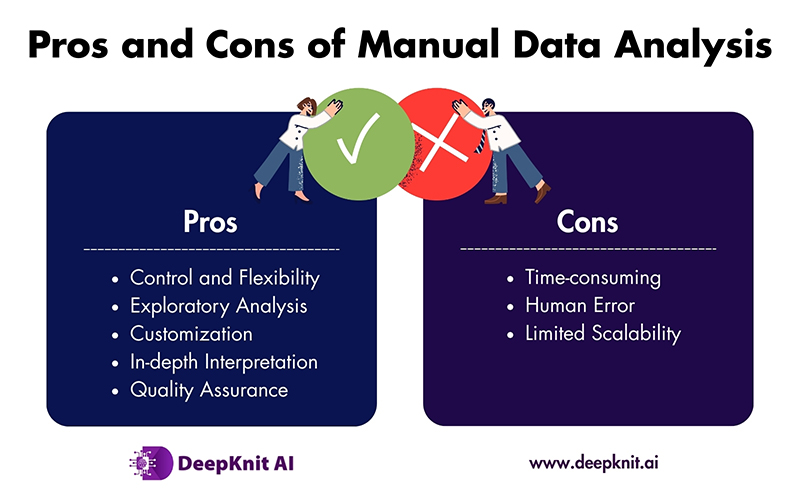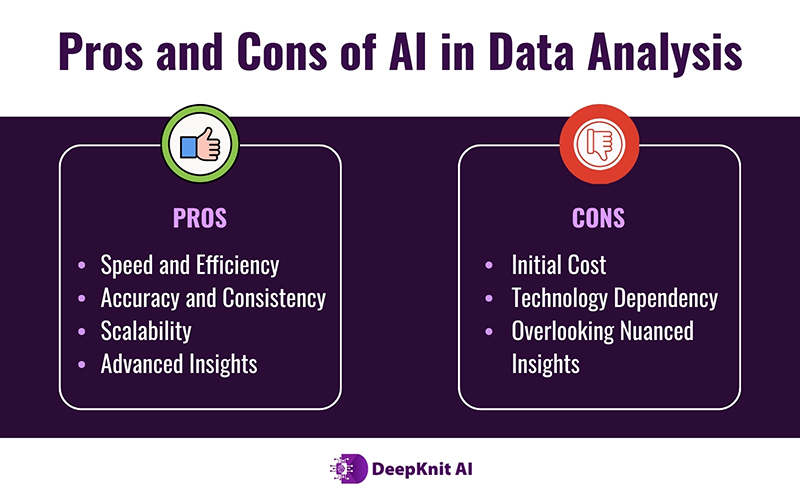In an age where every bit of data is gold (metaphorically, of course), how you process, analyze and interpret it can make or break your business. Though data analysis has been a staple for business growth for ages, the introduction of automation and artificial intelligence in data analysis has added a new dimension to it. ‘AI vs Manual Data Analysis’ is a hot topic, and it might be difficult to establish that one is better than the other, as both have their advantages and disadvantages. Even after a study by McKinsey says that “automation could raise productivity growth globally by 0.8 to 1.4 percent annually,” there’s an equal argument in favor of manual analysis, which remains invaluable for its deep customization and nuanced understanding of complex datasets. Besides, automated systems are not entirely autonomous, and the role of human intervention in AI-driven analytics remains significant when it comes to ensuring consistency and ruling out redundancy.
To begin with, though AI might seem like a better option considering its many advantages, AI data analysis can only be as good as the quality of the data you input. Inconsistent or flawed datasets can result in skewed results, whereas the traditional method can spot these flaws at the beginning stage itself and make necessary corrections.
The major differentiator between the manual and AI-automated methods is that the former is best suited for specific and smaller datasets, while automation in data processing is the best fit for larger and broader datasets. But that’s just a general outlook.
Without further ado, let’s take a look at the pros and cons of using AI and manual analysis of data.
AI Vs Manual Data Analysis
Manual Data Analysis
Manual data analysis methods involve examining datasets using traditional hands-on techniques. Unlike the automated process, which employs algorithms and software, it involves human intervention at each stage.
The following steps involving human intervention are followed in manual data analysis methods:
- Data Gathering: Data is compiled from various sources including databases, spreadsheets and external files.
- Data cleansing and error detection: Data is cross checked with the source for finding and fixing mistakes or discrepancies.
- Data Processing: This step involves aggregating, sorting, filtering, and organizing data to give it a proper structure.
- Data Interpretation: This is the final step that involves analysing the data to extract actionable insights, patterns and trends.
Advantages and Disadvantages of Manual Data Analysis
The following are the major pros and cons of manual data analysis:
Advantages
Even though manual data analysis has its limitations, it remains critical especially when coupled with Business Intelligence (BI) tools.
- Control and Flexibility: Manual processes enable a tailored approach to specific data sets as analysts have complete control over the process. This flexibility, which the automated process does not allow, comes very handy while dealing with unique or complex datasets.
- Exploratory Analysis: Manual processes are very useful for the initial analysis of newer datasets, as they can provide a thorough understanding of the data before implementing more automated approaches.
- Customization: Each business comes with its own unique challenges and requirements, and the manual method enables highly customized analysis and reporting. This is especially useful while dealing with smaller datasets where intricate details can be thoroughly examined to produce detailed, customized BI reports tailored to unique business requirements.
- In-depth Interpretation: Because of the direct engagement with the data, manual data analysis allows for deeper comprehension of the nuances and intricacies within the dataset. This enables a better understanding of underlying trends and more insightful interpretations.
- Quality Assurance: While BI software can automate much of the process, manual intervention is critical to ensure data quality and accuracy and to maintain high standards.
Disadvantages
- Time-consuming: Despite the benefits of the manual process, the biggest drawback is that it is tedious and time-consuming, which leads to delays in decision-making and reporting. This makes it unsuitable and inefficient for analyzing larger datasets.
- Human Error: Adding to the disadvantage of being a slower process is the factor of human error, which is inevitable. Mistakes made during data entry, cleansing, or sorting can lead to inaccurate interpretations, resulting in incorrect conclusions.
- Limited Scalability: The biggest drawback of the manual process is its limitation to deal with only smaller datasets. As the volume of data increases, it becomes almost impractical and unmanageable to employ the manual process as it would require more time and manual resources, ultimately increasing costs.
Artificial Intelligence in Data Analysis
Automation in data processing involves the handling and interpretation of data with the help of advanced technologies like AI, machine learning (ML), and specialized Business Intelligence (BI) tools. Contrary to the manual process that requires manual intervention at each stage, the automated process leverages sophisticated algorithms to accomplish tasks with speed and precision.
The steps involved in AI-automated data analysis are similar to those in the manual process, with the difference that it does not require manual intervention at each stage:
- Data Gathering: Similar to the manual process, the first step of automated data analysis is also the collection of data from multiple sources, but it does this in real time, ensuring a constant flow of information.
- Data Cleansing and Error Detection: Unlike the manual process that requires manual intervention and is prone to errors, the AI-enabled process uses advanced algorithms to detect and correct inconsistencies, errors, outliers and autofill missing data to ensure high quality data for analysis.
- Data Processing: The ML algorithms organize and structure the data efficiently, making it ready for in-depth analysis.
- Data Interpretation: Data analysis and interpretation are done with the help of BI software tools that apply statistical models and ML techniques to identify trends, patterns, and insights with minimal human intervention.
Pros and Cons of AI in Data Analysis
Here is a comprehensive list of the advantages and disadvantages of AI-automation in data analysis:
Advantages
- Speed and Efficiency: Larger datasets can be processed in real time and at high speeds with the help of AI-automated systems to quickly deliver actionable insights. This is useful to companies, especially when it comes to taking quick decisions.
- Accuracy and Consistency: The advanced BI software tools of automated systems can handle complex datasets with precision and this ensures high data integrity and consistency, while minimum human intervention means minimum human errors, and this guarantees accurate results.
- Scalability: The biggest advantage of the automated process is its scalability in data analysis. It can be easily scaled to handle higher data volumes as your business grows, without allocating any extra human resources. This makes it suitable for companies of all sizes – big or small.
- Advanced Insights: The AI and ML algorithms of automated systems can easily sift through large volumes of data to extract hidden patterns and insights. This helps businesses make more informed and strategic decisions.
Disadvantages
- Initial Cost: The initial investment to set up and implement automated systems, including software, hardware and training costs can be significantly high.
- Technology Dependency: Businesses relying entirely on automated systems run the risk of unwarranted disruptions in the event of system failures or if the technology becomes obsolete.
- Overlooking Nuanced Insights: Even though automated systems are adept at spotting hidden patterns and variables, they sometimes cannot match human expertise in detecting subtle insights that maybe subjective or contextual.
Conclusion
As is evident from all that has been discussed in this post, the choice between AI-automated and manual data analysis depends on factors such as data volume, accuracy needs, customization requirements, the need for scalability in data analysis in your business, and of course, the budget.
Though the AI-automated process looks like a better option compared to manual data analysis methods, no matter the size of your organization, it is worth noting that the role of human intervention in AI-driven analytics is not negligible. For AI systems to give optimum results, human intervention is still needed for regular data audits and to ensure that the input data in the automated systems is free of errors or inconsistencies. Besides, not all processes in your organization may be worth automating.
Artificial intelligence in data analysis is best implemented in phases, beginning with automating high-volume repetitive tasks, measuring the results, and then deciding what other processes in your organization need automation. Sometimes a good combination of manual and automated processes might be the best fit for you.
Are you at the crossroads of deciding what is best for your organization? DeepKnit AI’s experts can help you make the right choices.
Confused between Choosing AI and Manual analysis for your business?
Consult DK AI’s experts.
Contact Us



